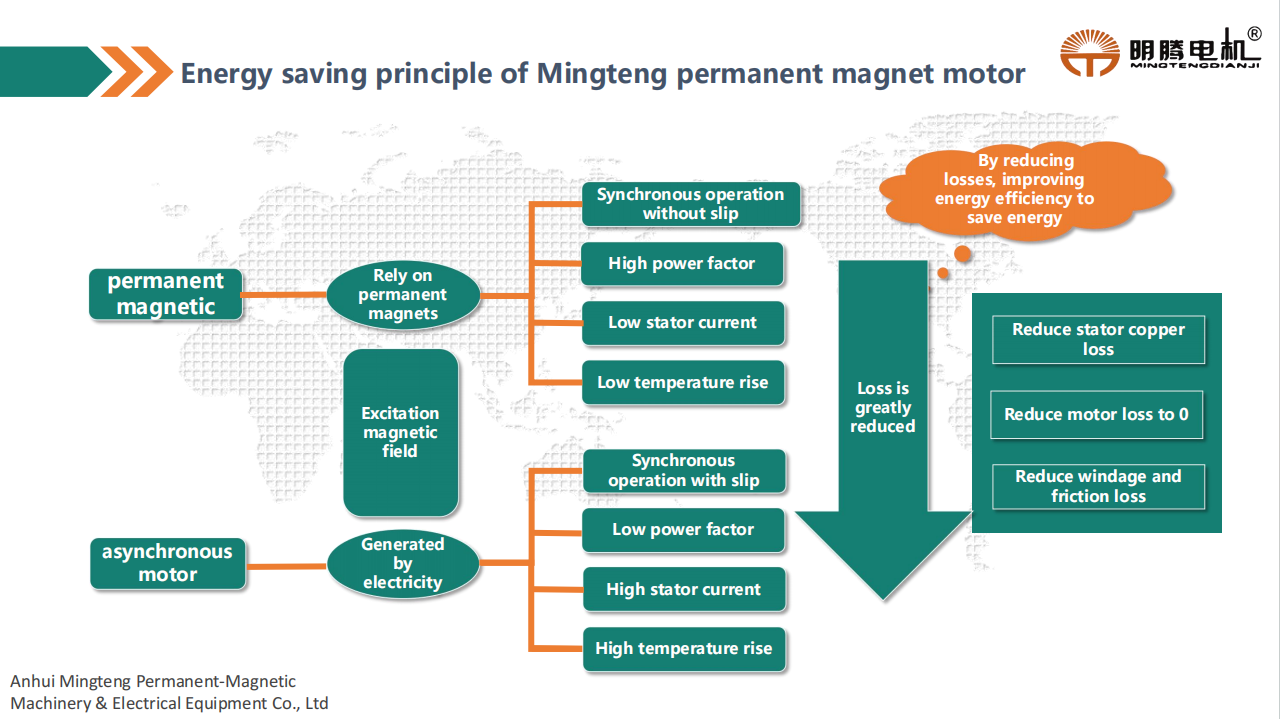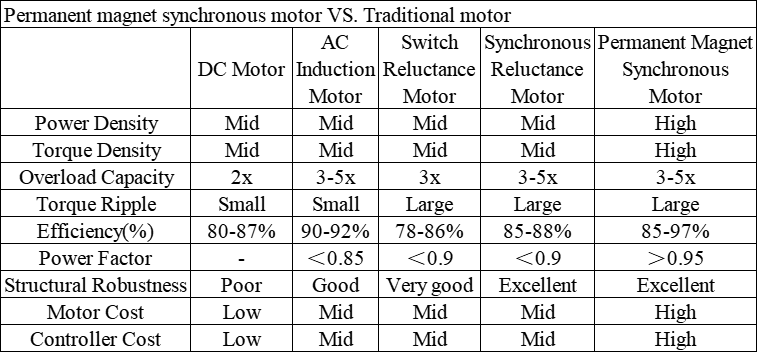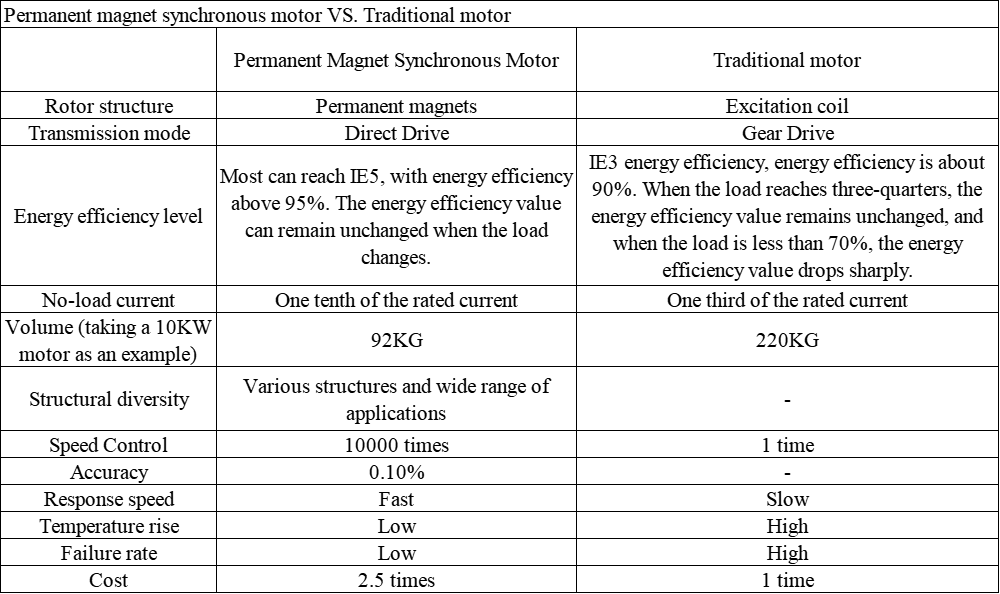1.Classification of permanent magnet motors and industry driving factors
There are many types, with flexible shapes and sizes. According to the motor function, permanent magnet motors can be roughly divided into three types: permanent magnet generators, permanent magnet motors, and permanent magnet signal sensors. Among them, permanent magnet motors are mainly divided into synchronous, DC, and stepper.
1)Permanent magnet synchronous motor:
The stator structure and working principle are consistent with those of traditional AC asynchronous motors. Due to its high functional factor and high efficiency, it has developed rapidly in recent years, gradually replacing traditional AC asynchronous motors, and is widely used in industrial automation, machine tools, printing, textiles, medical and other fields.
2)Permanent magnet DC motor:
The working principle and structure are similar to those of traditional DC motors. Based on the different commutation methods, it can be divided into brushed (mechanical commutation) and brushless (electronic commutation). It is widely used in electric vehicles, power tools, household appliances and other fields.
3)Permanent magnet stepper motor:
It uses the interaction between the magnetic field generated by the permanent magnet and the rotating magnetic field generated by the stator to achieve precise stepping motion. It has the advantages of high precision, fast response speed, and energy saving, and is widely used in precision instruments, automated production lines, medical equipment and other fields.
1.1 Driving factors
1.1.1 Product side
The working principle of permanent magnets is simple, and motor losses are greatly reduced. Overall, traditional electromagnetic motors need to rely on an external power supply to generate electromotive force for the generator, provide initial power, and then rely on their own output voltage to work. The working principle of permanent magnet motors is relatively simple, and the magnetic field only needs to be provided by permanent magnets.
Compared with traditional motors, the advantages of permanent magnet motors are mainly reflected in: ① low stator loss; ② no rotor copper loss; ③ no rotor iron loss; ④ low wind friction. However, it should be noted that the key component of permanent magnet motors is that the magnetic steel is not resistant to continuous high temperature. In order to avoid the situation where the motor performance is reduced or scrapped due to demagnetization, the working temperature of the motor needs to be reasonably controlled.
The energy-saving effect is significant and the overall efficiency is improved. Below, we conduct a specific performance analysis by distinguishing motor types and motor raw materials:
1) In terms of motor types
we selected permanent magnet synchronous motors for comparison with other traditional motors, among which switched reluctance motors, synchronous reluctance motors, and permanent magnet motors are all synchronous motors. Combined with the indicators, since permanent magnet motors do not require brushes and excitation currents, they have higher efficiency and power density than traditional motors. In terms of overload capacity, except for DC motors, which are relatively low, the other types are not much different. The efficiency and power factor of permanent magnet motors are the most outstanding performances, with an efficiency of 85-97%. Although small motors can usually reach more than 80%, permanent magnet motors have obvious advantages compared to the 40-60% efficiency of asynchronous motors. In terms of power factor, it can reach more than 0.95, indicating that the proportion of active current component of permanent magnet motors in total current is greater than that of other types, and the energy utilization rate is higher.
2) According to the raw materials of the motor
According to the magnetic strength and development stage of the permanent magnet materials used in the motor, permanent magnet motors can be divided into three categories: metal, ferrite, and rare earth. Among them, ferrite and rare earth permanent magnet motors are currently more widely used.
Compared with traditional motors, rare earth permanent magnet motors have a simpler structure and a lower failure rate. The use of rare earth permanent magnets can increase the air gap magnetic density, increase the motor speed to the best, and improve the power-to-weight ratio. The application field is relatively broad. The only disadvantage of permanent magnet motors is their high cost. Taking the price of rare earth permanent magnet motors as an example, it is usually more than 2.5 times higher than that of traditional motors.
1.1.2 Policy side
Policies also play an important role in promoting the development of permanent magnet motors.
1) The permanent magnet industry is experiencing rapid development driven by policies.
As the core raw material of permanent magnet motors, the improvement of technology and popularity of permanent magnets has an important impact on the development of permanent magnet motors. In recent years, the government has taken relevant measures in terms of industry support, policy stimulus and standard formulation to actively promote the widespread application of permanent magnet materials and promote the development and expansion of permanent magnet motors.
2)Stimulate growth potential under the demand for energy conservation and emission reduction.
With China’s increasing emphasis on energy conservation and environmental protection, the healthy development of permanent magnet motors has ushered in growth opportunities. Since the establishment of the new national standard in 2020, China no longer produces motors below the international standard IE3, and is forced to use more efficient products. In addition, the “Energy Efficiency Improvement Plan” released in 2021 and 2022 proposed that in 2023, the annual output of high-efficiency energy-saving motors will be 170 million kilowatts, and the proportion of high-efficiency energy-saving motors in service will exceed 20%; in 2025, the proportion of new high-efficiency energy-saving motors will exceed 70%. Calculated at a ratio of 1 kilowatt-hour: 0.33 kilograms, it is equivalent to saving 15 million tons of standard coal and reducing carbon dioxide emissions by 28 million tons per year, which is expected to drive permanent magnet motors into an era of rapid growth.
2.Analysis of the Permanent Magnet Motor Industry Chain
Looking at the upstream of the entire industry chain, we will find that the main raw materials necessary for the production of permanent magnet motors include various magnetic materials (such as neodymium iron boron magnets, permanent magnetic ferrites, samarium cobalt, aluminum nickel cobalt, etc.), copper, steel, insulation materials and aluminum, among which high-efficiency magnetic materials are the core of manufacturing high-performance permanent magnet motors. For the downstream of the permanent magnet motor industry, it is mainly various end application fields, including wind energy, new energy vehicles, aerospace, textile industry, water treatment, etc. With the continuous upgrading of the downstream manufacturing industry, the growth in demand in the terminal application market is expected to further promote the large-scale production of permanent magnet motors.
2.1 Upstream: High-quality magnetic materials contribute to the cost, accounting for more than 25%
Materials account for more than half of the total cost, among which magnetic materials play a decisive role in motor efficiency. The upstream raw materials of permanent magnet motors mainly include magnetic materials (such as neodymium iron boron magnets, permanent magnet ferrites, samarium cobalt, aluminum nickel cobalt, etc.), silicon steel sheets, copper, steel, aluminum, etc. Magnetic materials, silicon steel sheets and copper are the main part of the raw material cost, accounting for more than 50% of the cost. Although according to the cost structure of traditional motors, the initial purchase, installation and maintenance costs of the motor only account for 2.70% of the entire life cycle of the motor, due to factors such as product pricing, competitiveness and market popularity, motor manufacturers pay great attention to raw materials.
1) Magnetic materials:Rare earth magnets have excellent magnetic properties and are very suitable for high-performance and high-power applications. NdFeB and cobalt magnets are important rare earth applications in permanent magnet materials. Due to China’s rich rare earth reserves, the production of NdFeB accounts for about 90% of the world’s total. Since 2008, China’s permanent magnet motor production has risen rapidly, gradually becoming the world’s major producer, and the demand for NdFeB raw materials has doubled between 2008 and 2020. Due to the particularity of rare earth resources, the production and processing of NdFeB is relatively complicated, so the price of permanent magnet motors is higher than that of traditional motors. Magnetic materials usually account for about 30% of the total cost.
2) Silicon steel sheet:Mainly used to form the core part of permanent magnet motor. Due to the complex preparation process, its cost is relatively high. Silicon steel sheet accounts for about 20% of the total cost.
3) Copper: Mainly used as the conductor material of permanent magnet motors, accounting for about 15% of the total cost.
4) Steel: Mainly used to manufacture the structure and shell material of permanent magnet motors, accounting for about 10% of the total cost.
5) Aluminum: Mainly used to make heat sinks, end covers and other heat dissipation components.
6) Manufacturing equipment and tool costs: accounting for about 15% of the total cost.
2.2 Downstream: Multiple fields are preparing to make efforts, and huge potential in the industry is waiting to be tapped
Permanent magnet motors have now been widely used in various fields and across multiple industries. So far, permanent magnet motors have successfully entered the automotive, home appliance, industrial automation and other industries, making a strong contribution to technological innovation and market expansion. In addition, given its importance to economic development, industries such as petrochemicals, oil and gas, metallurgy, and electricity have also begun to gradually use permanent magnet motors. In the future, as industry trends focus more on intelligence, automation, and energy conservation, the application of permanent magnet motors in various downstream fields will have huge potential and continue to maintain a rapid development momentum.
3.Permanent Magnet Motor Market Analysis
3.1 About supply and demand
Driven by the development of new energy, demand is growing rapidly. China’s rare earth permanent magnet motor manufacturers are mainly distributed in East China and South China, which are rich in rare earth resources and have a strong industrial foundation. There is a strong demand for permanent magnet motors, which is conducive to the formation of a complete industrial chain. From 2015 to 2021, China’s rare earth permanent magnet motor output increased from 768 million units to 1.525 billion units, with a compound annual growth rate of 12.11%, significantly exceeding the average growth rate of micromotors (motors with a diameter of less than 160mm or a rated power of less than 750mW) of 3.94%.
Thanks to the rapid development of the new energy field, the demand for permanent magnet motors in downstream fields such as wind power and electric vehicles has been increasing rapidly in recent years. In 2021 and 2022, China’s demand for rare earth permanent magnet motors will be 1.193 billion units and 1.283 billion units, respectively, a year-on-year increase of 7.54%.
3.2 About Market Size
China’s permanent magnet motor market is showing strong growth momentum, and the promotion of downstream fields has stimulated market potential. In the past few years, the global permanent magnet motor market has maintained steady growth and shown an optimistic development trend. In 2022, the market size reached US$48.58 billion, a year-on-year increase of 7.96%. It is estimated that by 2027, the global permanent magnet motor market will reach US$71.22 billion, with a compound annual growth rate of 7.95%. Driven by downstream fields such as new energy vehicles, variable frequency air conditioners, and wind power, China’s permanent magnet motor market is showing a rapid growth trend. At present, products with a power range of 25-100KW dominate the market.
The market continues to grow steadily, and China is leading the development of this industry. With the improvement of permanent magnet material performance and the advancement of motor technology, the global permanent magnet motor market will maintain steady growth. China will continue to maintain its market leadership. In the future, the integration of the Yangtze River Delta, the development of the western region, consumption upgrades, and policy promotion will provide a strong impetus for the large-scale application of permanent magnet motors in the Chinese market.
4.Global Competition Landscape of Permanent Magnet Motors
In the development of permanent magnet motors around the world, China, Germany and Japan have become leaders in high-end, precision and innovative permanent magnet motors with their years of manufacturing experience and key technologies.
China has become an important base for the global permanent magnet motor industry, and its competitiveness is increasing.
In terms of regional layout, Jiangsu, Zhejiang, Fujian, Hunan and Anhui have become important bases for China’s permanent magnet motor industry, occupying a considerable market share.
In the future, the global permanent magnet motor industry will usher in a more intense competition, and China, as the world’s most dynamic and potential market, will play an important role in this process.
5.Introduction to Anhui Mingteng Permanent Magnet Motor
Anhui Mingteng Permanent-Magnetic Machinery&Electrical Equipment Co., Ltd. (https://www.mingtengmotor.com/) was established on October 18, 2007 with a registered capital of RMB 144 million. It is located in Shuangfeng Economic Development Zone, Hefei City, Anhui Province. It is a modern high-tech enterprise integrating permanent magnet motor research and development, manufacturing, sales and services.
The company has always focused on product research and development. It has a permanent magnet motor professional research and development team of more than 40 people and has established long-term cooperative relations with universities, research institutions and large state-owned enterprises. The R&D team adopts modern motor design theory and advanced motor design technology. After more than ten years of technical accumulation, it has developed nearly 2,000 specifications of permanent magnet motors such as conventional, variable frequency, explosion-proof, variable frequency explosion-proof, direct drive, and explosion-proof direct drive series. It fully understands the technical requirements of various drive equipment in various industries and has mastered a large amount of first-hand design, manufacturing, testing, and use data.
Mingteng’s high and low voltage permanent magnet motors have been successfully operated on multiple loads such as fans, water pumps, belt conveyors, ball mills, mixers, crushers, scrapers, oil pumps, spinning machines, etc. in different fields such as mining, steel, and electricity, achieving good energy-saving effects and gaining wide acclaim.
Mingteng has always insisted on independent innovation, adhering to the corporate policy of “first-class products, first-class management, first-class services, and first-class brands”, tailoring intelligent permanent magnet motor system energy-saving overall solutions for users, building a permanent magnet motor R&D and application innovation team with Chinese influence, and striving to become the leader and standard setter in China’s rare earth permanent magnet motor industry.
Copyright: This article is a reprint of the original link:
https://mp.weixin.qq.com/s/PF9VseLCkGkGywbmr2Jfkw
This article does not represent our company’s views. If you have different opinions or views, please correct us!
Post time: Sep-27-2024



